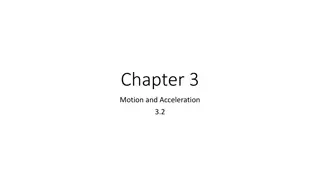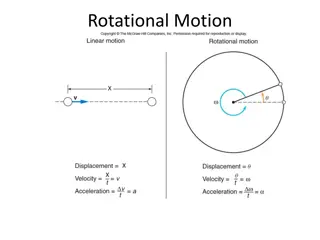Physics Concepts: Angular Velocity, Radians, and Acceleration Explained
Understand essential physics concepts such as angular velocity in radians, comparison of angular velocities, tangential velocity, magnitudes of velocities, and angular acceleration as applied to various scenarios like rotating wheels, clock hands, and spinning objects. Dive into the relationships between degrees and radians, magnitudes of angular velocities, and accelerations in real-world examples.
Download Presentation

Please find below an Image/Link to download the presentation.
The content on the website is provided AS IS for your information and personal use only. It may not be sold, licensed, or shared on other websites without obtaining consent from the author. Download presentation by click this link. If you encounter any issues during the download, it is possible that the publisher has removed the file from their server.
E N D
Presentation Transcript
How many degrees in 1 radian? A) 1 rad = 2? degrees B) 1 rad = 180 C) 1 rad = 10 180 ? D) 1 rad = 57.3 = E) A radian is not a measure of angle, so the question makes no sense.
A pocket watch and Big Ben are both keeping perfect time. Which minute hand has the larger magnitude angular velocity ?? pocket watch Big Ben A) Pocket watch s B) Big Ben s C) Same ? on both
A pocket watch and Big Ben are both keeping perfect time. Which minute hands tip has the larger magnitude tangential velocity v? pocket watch Big Ben A) Pocket watch s B) Big Ben s C) Same v on both
A small and a large wheel are connected by a belt. The small wheel turns at constant angular velocity ??. The belt does not slip. How does the magnitude of the angular velocity of the large wheel ?? compare to that of the small wheel? A) ??= ?? B) ??< ?? C) ??> ??
In the previous question, there is a bug S on the rim of the small wheel and another bug L on the rim of the large wheel. How do their speeds compare? Again, the belt does not slip. A) ??= ?? B) ??< ?? C) ??> ??
A student sees this question on an exam: A flywheel, mass ? = 120 kg, radius ? = 0.6 m, starts at rest, with given angular acceleration ? = 0.1 many revolutions has the wheel undergone after 10 s? To solve the problem using one formula, which should she use? rads2. How A) ? = ?0+ ?? B) ? = ?0+ ?0t +1 2??2 C) ?2= ?02+ 2? ? ?0
How many of the following statements about the minute hand of a clock are true? The tangential acceleration is zero The centripetal acceleration is zero pocket watch Big Ben The angular acceleration is zero A) None are ture B) One is true C) Two are true D) All three are true
A ladybug clings to the rim of a spinning wheel, spinning CCW and speeding up. At the moment shown, when the bug is at the far right, what is the approximate direction of the ladybug's acceleration vector ?? A) B) C) D) E)
What is the magnitude of the angular acceleration ? of a wheel spinning at a constant rate (with a ladybug at the edge traveling at speed ? at the moment shown?) A) 0 ?2 B) ? C) ? 2?? D) ? E) None of these
Three forces (A, B, C) are applied to a rod which pivots on an axis through its center. Which force causes the largest magnitude torque? [Note: cos45 = sin45 = 2= 0.71] 1 C B A 2F F 45o F axis R/2 R/4 R A) A B) B C) C D) 2 or more tie for the largest torque
A small mass hangs from the end of a light horizontal bar which pivots about an axis through it center, but is being held stationary. The bar is then released and begins to rotate. As the bar rotates from horizontal to vertical, the magnitude of the torque on the bar A) increases. B) decreases. C) remains constant.
Three forces are applied to a rod which rotates about the center. What is the net torque about the axis? Use our sign convention. A) ?? B) ?? C) 0 D) 3?? E) 3??
What is the magnitude of the torque about the axis? A) ?? sin? B) ?? cos?
A light rod of length 2? has 2 small heavy masses (each with mass ?) attached at the end and the middle. The fixed axis of rotation is at the left end, as shown. What is the moment of inertia about the axis? L L m m axis A) 2??2 B) 3??2 C) 4??2 D) 5??2 E) None of these
A light rod of length 2? has 2 small heavy masses (each with mass ?) attached at the end and the middle. The fixed axis of rotation is at the left end, as shown. What is the magnitude of the net torque due to gravity? L L m m axis A) 2??? B) 3??? C) 4??? D) 5??? E) None of these
A light rod of length 2? has 2 small heavy masses (each with mass ?) attached at the end and the middle. The fixed axis of rotation is at the left end, as shown. If the bar is released from rest, what is the magnitude of the initial angular acceleration? L L m m axis 3? 5? A) 5? 3? B) 7? 3? C) 3? 5? D) E) None of these
The two rulers have the same torque applied (1 weight at end vs. 2 weights in middle). Which will swing faster when released? A) The ruler with 1 weight at the end B) The ruler with 2 weights in the middle C) Both the same
Consider a light rotating rod with 4 point masses attached to it at distances 2 and 4, as shown. The axis of rotation is thru the center of the rod, perpendicular to its length. The 4 masses are moved to new positions so that all masses are now 3 units from the axis. The moment of inertia (?) A) increased. B) decreased. C) remained the same.
A mallet consists of a heavy steel cubical head on a light wooden handle. About which axis of rotation is the moment of inertia ? maximum? A B C D E) More than one is tied for max
Consider a solid disk with an axis of rotation through the center (perpendicular to the diagram). The disk has mass ? and radius ?. A small mass ? is placed on the disk s rim. What is the moment of inertia of the system? A) I = (? + ?)?2 B) I > (? + ?)?2 C) I < (? + ?)?2
An irregularly-shaped object of total mass ? is free to rotate about a frictionless axis. The moment-of-inertia about the axis is ?. The object, initially at rest, is acted on by a torque of constant magnitude ? for time ? and reaches a final angular velocity of ?. There are no other torques acting. What is the time ? required to achieve the final angular velocity ? of the object? axis ?? ? A) M, I ?? ? M, I B) ?? ? C) D) 0 E) None of these
A very light rod of length ? has a mass ? at the top end. The bottom end is placed on the ground and the rod is released from rest at an angle ?. It falls over, rotating about the fixed bottom end. As the rod falls over (as ? decreases to zero), the angular acceleration ? A) increases. B) decreases. C) remains constant.
Mass ? hangs from string wrapped around a pulley of radius ?. The pulley has moment of inertia ? and its pivot is frictionless. Because of gravity, the mass accelerates downward and the pulley rotates. Which has greater magnitude, the string tension ? or the weight ??? A) ? = ?? B) ? < ?? C) ? > ??
Mass ? hangs from string wrapped around a pulley of radius ?. The pulley has moment of inertia ? and its pivot is frictionless. Because of gravity, the mass accelerates downward and the pulley rotates. The magnitude of the torque on the pulley is A) greater than ???. B) less than ???. C) equal to ???.
A sphere, a hoop, and a cylinder, all with the same mass ? and same radius ?, are rolling along, all with the same speed ?. Which has the most total kinetic energy? [Note: ?sphere=2 5??2, ?hoop= ??2, ?disk=1 2??2] Sphere Hoop Disk v v v A) Sphere B) Hoop C) Disk D) All have the same total KE
Two wheels, with the same radius ? and same total mass ?, rotate about their fixed axles. Wheel A is a hoop (all the mass is near the rim). Wheel B is a disk (mass is spread out uniformly). Which has the larger moment of inertia ? = ?????2? hoop disk M, R M, R A) The hoop B) The disk C) They are tied
A disk and a hoop both start from rest at the top and roll down an incline. (I am not specifying whether ? or ? are the same). Which one wins the race? A) Disk B) Hoop C) Tie D) Depends on the M s and R s!
A disk and a hoop, both with the same mass ? and the same radius ?, both start from rest at the top and roll down an incline. Which one has the largest total kinetic energy (KEtot= KEtrans+ KErot) at the bottom? A) Disk B) Hoop C) Same KEtot for both
A hoop and a disk, both with the same mass M and the same radius R, both roll without slipping with the same speed v, and are rolling toward an inclined plane, as shown. Which object will roll up to the greatest height on the incline? A) Disk B) Hoop C) Same max for both
A frictionless sliding hockey puck and a rolling hoop each have the same mass ? and the same initial speed ?. Assume that each has more than enough initial KE to easily travel up the hill. Which object has more total KE at the top of the hill? m h v v m A) Hoop B) Puck C) Same KE at top
A disk is spinning as shown with angular velocity ?. It begins to slow down. While it is slowing, what is the direction of its vector angular acceleration, ?? A) B) C) D) E) None of these























